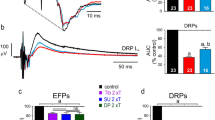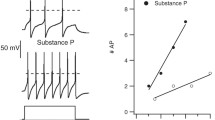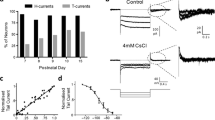Abstract
The development of intensive depolarization of terminals through stimulation of the afferent nerve or dorsal root of sufficient strength causes the appearance of antidromic discharges recordable as a dorsal-root reflex. The discharges were shown to spread simultaneously in the dorso-ventral direction, with consequent facilitation of spinal reflexes. The results suggest the possible existence of two types of effect of presynaptic depolarization on spinal afferent pathways.
Similar content being viewed by others
Literature cited
Yu. A. Galyas and A. K. Florov, "The specialized computer for statistical analysis of signals," Abstracts of Proceedings of the Twenty First Republican Scientific-Technical Conference to Commemorate the Fiftieth Anniversary of Foundation of the USSR [in Russian], Kiev (1972), pp. 39–40.
N. V. Golikov, "The problem of local and spreading excitation in modern neurophysiology," in: Mechanisms of the Local Response and Spreading Excitation [in Russian], Nauka, Leningrad (1970), pp. 5–12.
T. K. Ioseliani, Neural Mechanisms of Integrative Activity of the Spinal Cord [in Russian], Metsniereba, Tbilisi (1970).
G. N. Kryzhanovskii and V. K. Lutsenko, "Dorsal-root potentials of the spinal cord in rats with a seizure syndrome in ascending tetanus," Byull. Éksperim. Biol. Med.,67, No. 2, 16 (1969).
G. N. Kryzhanovskii and V. K. Lutsenko, "Dorsal-root potentials in rats with a seizure syndrome in ascending tetanus," Byull. Éksperim. Biol. Med.,70, No. 3, 25 (1970).
E. Kh. Kutsenko, "On central effects of afferent impulses in high-threshold muscle fibers," Author's Abstract of Candidate's Dissertation, Dnepropetrovsk (1971).
V. K. Lutsenko and G. N. Kryzhanovskii, "The nature of tonic activity in rats with a seizure syndrome in ascending tetanus," Byull. Éksperim. Biol. Med.,75, No. 6, 6 (1973).
P. E. Motsnyi, A. B. Murzin, and O. A. Shugurov, "On mechanisms of inhibition of the first negative component of the dorsal-root potential during repetitive stimulation of a peripheral nerve," Nauch. Dokl. Vyssh. Shkoly. Biol. Nauki,9, 49 (1967).
P. E. Motsnyi, E. M. Tolkacheva, and O. A. Shugurov, "Presynaptic inhibition of segmental interneurons," Neirofiziologiya,4, 75 (1972).
Yu. S. Sverdlov and G. V. Burlakov, "Inhibitory processes in the spinal cord of cats with local tetanus," Fiziol. Zh. SSSR,51, 90 (1965).
Yu. S. Sverdlov, "Potentials of spinal motoneurons in cats with experimental tetanus," Neirofiziologiya,1, 25 (1969).
E. M. Tolkacheva and O. A. Shugurov, "Investigation of presynaptic inhibition evoked by stimulation of relatively high-threshold afferents," in: Problems in Neurocybernetics [in Russian], Rostov University Press, Rostov-on-Don (1972), p. 239.
A. K. Florov, "Origin of the dorsal-root potential," Author's Abstract of Candidate's Dissertation, Dnepropetrovsk (1966).
B. I. Khodorov, The Problem of Excitability [in Russian], Meditsina, Leningrad (1969).
O. A. Shugurov, "Investigation of mechanisms of regulation acting at the input to the spinal cord," Author's Abstract of Doctoral Dissertation, Moscow (1971).
J. C. Eccles, The Physiology of Synapses, Springer, Berlin (1964).
D. H. Barron and B. H. C. Matthews, "The interpretation of potential changes in the spinal cord," J. Physiol. (London),92, 276 (1938).
K. Bradley and G. G. Somjen, "Accomodation in motoneurones of the rat and cat," J. Physiol. (London),156, 75 (1961).
C. McC. Brooks and K. Koizumi, "Origin of dorsal-root reflex," J. Neurophysiol.,19, 61 (1956).
J. C. Eccles, R. M. Eccles, and F. Magni, "Central inhibitory action attributable to presynaptic depolarization produced by muscle afferent volleys," J. Physiol. (London),159, 147 (1961).
J. C. Eccles, "Presynaptic and postsynaptic inhibitory actions in the spinal cord," in: Brain Mechanisms (ed. by G. Moruzzi), Elsevier, Amsterdam (1963).
J. C. Eccles, P. G. Kostyuk, and R. F. Schmidt, "Presynaptic inhibition of the central actions of the flexor reflex afferents," J. Physiol. (London),161, 258 (1961).
J. C. Eccles, W. Kozak, and F. Magni, "Dorsal-root reflexes of muscle group 1 afferent fibres," J. Physiol. (London),159, 128 (1961).
J. C. Eccles and J. L. Malcolm, "Dorsal-cord potentials of the spinal cord," J. Neurophysiol.,9, 139 (1946).
J. C. Eccles, R. F. Schmidt, and W. D. Willis, "Presynaptic inhibition of the spinal monosynaptic reflex pathway," J. Physiol. (London),161, 282 (1962).
J. C. Eccles, R. F. Schmidt, and W. D. Willis, "The location and the mode of operation of the presynaptic inhibitory pathways on the group 1 afferent fibres from muscle," J. Neurophysiol.,26, 506 (1963).
J. C. Eccles, R. F. Schmidt, and W. D. Willis, "The mode of operation of the synaptic mechanism producing presynaptic inhibition," J. Neurophysiol.,26, 523 (1963).
J. C. Eccles, R. F. Schmidt, and W. D. Willis, "Depolarization of the central terminals of cutaneous afferent fibres," J. Neurophysiol.,26, 646 (1963).
J. C. Eccles and W. D. Willis, "Presynaptic inhibition of the monosynaptic reflex pathway in kittens," J. Physiol. (London),165, 403 (1963).
D. P. Lloyd and A. K. McIntyre, "On the origin of dorsal-root potentials," J. Gen. Physiol.,32, 409 (1949).
R. Melzack and P. D. Wall, "Pain mechanism: a new theory," Science,150, 971 (1965).
L. M. Mendell and P. D. Wall, "Presynaptic hyperpolarization: a role for fine afferent fibres," J. Physiol. (London),172, 274 (1964).
K. Sasaki and T. Otani, "Accommodation in spinal motoneurones of the cat," Jap. J. Physiol.,11, 443 (1961).
R. F. Schmidt and W. D. Willis, "Depolarization of central terminals of afferent fibres in the cervical spinal cord of the cat," J. Neurophysiol.,26, 44 (1963).
C. R. Skoglund, "The response to linearly increasing currents in mammalian motor and sensory nerves," Acta Physiol. Scand.,4, Suppl. 12, 75 (1942).
J. Toennies, "Reflex discharges from the spinal cord over dorsal roots," J. Neurophysiol.,1, 378 (1938).
P. D. Wall, "Presynaptic control of impulses at the first central synapse in the cutaneous pathway," Prog. Brain Res.,12, 92 (1964).
Additional information
Dnepropetrovsk State University. Translated from Neirofiziologiya, Vol. 7, No. 5, pp. 519–526, September–October, 1975.
Rights and permissions
About this article
Cite this article
Krokhina, O.S., Shugurov, O.A. Possibility of different effects of primary afferent depolarization on spinal reflexes. Neurophysiology 7, 402–408 (1975). https://doi.org/10.1007/BF01067810
Received:
Issue Date:
DOI: https://doi.org/10.1007/BF01067810




